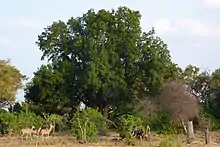Xanthocercis zambesiaca
Xanthocercis zambesiaca, the Nyala tree, is a species of legume in the family Fabaceae which is native to the southern subtropics of sub-Saharan Africa. It occurs at low altitudes in Botswana, Malawi, Mozambique, South Africa, Zambia and Zimbabwe.[2]
| Nyala tree | |
|---|---|
 | |
| Scientific classification | |
| Kingdom: | |
| (unranked): | |
| (unranked): | |
| (unranked): | |
| Order: | |
| Family: | |
| Genus: | |
| Species: | X. zambesiaca |
| Binomial name | |
| Xanthocercis zambesiaca (Baker) Dumaz-le-Grand | |
| Synonyms | |
| |
Nyala trees grow along rivers or termite mounds where they have access to plentiful moisture and fertile soil. They are prolific in the Tuli Block of Botswana along the Limpopo and Shashe rivers where they are known as Mashatu trees. The Nyala tree is a phreatophyte - it indicates the presence of ground water. The wood of a nyala tree can be worked, finishing with a smooth appearance, but irritates the nose and throat in the process.[3]
_leaves_(11711501986).jpg.webp)
foliage _old_fruits_(11710937343).jpg.webp)
fruit
References
- Botanic Gardens Conservation International (BGCI) & IUCN SSC Global Tree Specialist Group (2019). "Xanthocercis zambesiaca". IUCN Red List of Threatened Species. 2019: e.T146210831A146210833. doi:10.2305/IUCN.UK.2019-2.RLTS.T146210831A146210833.en. Retrieved July 28, 2020.
- "Xanthocercis zambesiaca". Germplasm Resources Information Network (GRIN). Agricultural Research Service (ARS), United States Department of Agriculture (USDA). Retrieved 21 January 2018.
- Emmett, Megan; Pattrick, Sean (2012). Game Ranger in Your Backpack: All-in-one Interpretative Guide to the Lowveld. Briza. ISBN 978-1-920217-06-8.
This article is issued from Wikipedia. The text is licensed under Creative Commons - Attribution - Sharealike. Additional terms may apply for the media files.
